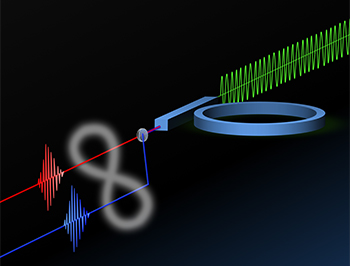
The silicon ring resonator emits in the telecom band and outputs into a photonic waveguide: green represents the laser pump; red and blue wavepackets are photon pairs; and the infinity symbol indicates entanglement. Credit: Università degli Studi di Pavia, Italy
A new microring resonator design, consisting of loops etched onto a silicon wafer, could provide a practical source of time-energy entangled photon pairs and is small enough to fit on a standard silicon chip. Entangled photon emitters are commonly made from nonlinear crystals, but even at the millimeter scale, they are too big and require too much energy for on-chip applications. The new resonators are only 20 microns across and could facilitate quantum information technologies, including secure quantum cryptography (Optica, doi: 10.1364/OPTICA.2.000088).
To create their microring resonators, the international team of researchers etched loops onto a silicon wafer. The resonator is powered by a laser beam directed along an optical fiber that is coupled to the wafer. When the laser light enters the resonator, the photons mingle and become entangled as they “race” around the loops. The team was able to confirm that photons expelled from the resonator were entangled using a Franson experiment to show a violation of Bell’s inequality by 7.1 standard deviations with an internal pair generation exceeding 107 Hz. Microring resonators have been used in the past as efficient sources of paired photons, but, to the best of the team’s knowledge, this is the first record of entangled photons exiting a microring resonator.
Corresponding author Daniele Bajoni, from the Università degli Studi di Pavia, Italy, said “The rate at which the entangled photons are generated [in the microring resonator] is unprecedented for a silicon integrated source, and comparable with that available from bulk crystals that must be pumped by very strong lasers.” The silicon microring resonators could, according to the authors, help revolutionize computing, communications and cyber security.
